The invention of the telephone revolutionized communication and transformed how people connect, bridging distances and facilitating real-time interaction across the globe. Since its inception, the phone has been crucial in shaping human relationships, fostering collaboration, and bringing together people from diverse backgrounds and cultures.
Here are some ways in which the invention of the phone has helped connect people from around the world:
Instant Communication:
Before the invention of the telephone, communication over long distances was limited to written correspondence, which could take days, weeks, or even months to reach its destination. With the telephone, individuals could communicate instantaneously, exchanging information, ideas, and emotions in real-time regardless of geographical barriers. The ability to have spontaneous conversations across vast distances transformed how people interact and strengthened connections between individuals and communities worldwide.
Facilitating Business and Commerce:
The telephone has been instrumental in facilitating business and commerce on a global scale. Businesses can now efficiently conduct transactions, negotiate deals, and collaborate with partners and customers across continents. From multinational corporations to small businesses, the telephone has become an indispensable tool for conducting business across borders and driving economic growth.
Connecting Loved Ones:
The telephone has been essential in reuniting loved ones who are separated by distance and enabling families and friends to communicate no matter where they are. Whether it’s a quick hello, a poignant chat with a relative, or a video chat with a loved one worldwide, the phone has forged deep bonds and facilitated important social interactions. Hearing a loved one’s voice or seeing their face in real-time can provide comfort, support, and a sense of closeness, even when separated by thousands of miles.
Cultural Exchange and Understanding:
The telephone has facilitated cultural exchange and understanding by allowing individuals worldwide to communicate directly. Conversations enable people to exchange experiences, customs, and viewpoints, promoting respect and understanding amongst people from different cultural backgrounds. The telephone has enabled cross-cultural collaboration, dialogue, and friendship, breaking down barriers and promoting empathy and respect for cultural differences.
Emergency Communication and Crisis Response:
In times of crisis or emergency, the telephone serves as a lifeline for communication and coordination. Whether during natural disasters, medical emergencies, or other crises, the ability to quickly communicate with emergency services, first responders, and loved ones can be a matter of life and death.
Political and Social Movements:
From grassroots organizing to mass protests, the telephone has been used to coordinate actions, disseminate information, and galvanize support for causes and movements around the world. The telephone has empowered people to advocate for change and challenge injustice globally by connecting individuals and amplifying their voices.
The invention of the telephone has transformed communication and connected people worldwide in unimaginable ways. From instant communication and business collaboration to connecting loved ones and fostering cultural exchange, the telephone has become an indispensable tool for building relationships, promoting understanding, and driving positive change on a global scale.










